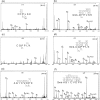N-Terminal Derivatization with Structures Having High Proton Affinity for Discrimination between Leu and Ile Residues in Peptides by High-Energy Collision-Induced Dissociation
- PMID: 27900234
- PMCID: PMC5121197
- DOI: 10.5702/massspectrometry.A0051
N-Terminal Derivatization with Structures Having High Proton Affinity for Discrimination between Leu and Ile Residues in Peptides by High-Energy Collision-Induced Dissociation
Abstract
De novo sequencing is still essential in the identification of peptides and proteins from unexplored organisms whose sequence information is not available. One of the remaining problems in de novo sequencing is discrimination between Leu and Ile residues. The discrimination is possible based on differences in side chain fragmentation between Leu and Ile under high-energy collision-induced dissociation (HE-CID) conditions. However, this is observed only when basic residues, such as Arg and Lys, are present near the N- or C-terminal end. It has been shown that the charge derivatization at the N-terminal end by a quarternary ammonium or phosphonium moiety facilitates the side chain fragmentation by HE-CID. However, the effective backbone fragmentation by low-energy CID (LE-CID) is often hampered in those derivatives with a fixed charge. Previously, we demonstrated that the N-terminal charge derivatization with the structures having high proton affinity induced the preferential formation of b-ions under LE-CID conditions, allowing straightforward interpretation of product ion spectra. In the present study, we further investigated whether the same derivatization approach is also effective for discrimination between Leu and Ile under HE-CID conditions. Consequently, the side chain fragmentation of Leu and Ile residues was most effectively enhanced by the N-terminal derivatization with 4-(guanidinomethyl)benzoic acid among the tested structures. This derivatization approach, which is compatible with both HE- and LE-CID analysis, offers a straightforward and unambiguous de novo peptide sequencing method.
Keywords: MALDI-TOF-TOF; de novo sequencing; ion trap-TOF; proton affinity.
Figures




References
-
- 1) A. I. Nesvizhskii. Protein identification by tandem mass spectrometry and sequence database searching. Methods Mol. Biol. 367: 87–119, 2007. - PubMed
-
- 3) P. P. Hurtado, P. B. O’Connor. Differentiation of isomeric amino acid residues in proteins and peptides using mass spectrometry. Mass Spectrom. Rev. 31: 609–625, 2012. - PubMed
-
- 4) W. D. van Dongen, H. F. M. Ruijters, H. J. Luinge, W. Heerma, J. Haverkamp. Statistical analysis of mass spectral data obtained from singly protonated peptides under high-energy collision-induced dissociation conditions. J. Mass Spectrom. 31: 1156–1162, 1996. - PubMed
-
- 5) J. T. Stults, J. Lai, S. Mccune, R. Wetzel. Simplification of high-energy collision spectra of peptides by amino-terminal derivatization. Anal. Chem. 65: 1703–1708, 1993. - PubMed
LinkOut - more resources
Full Text Sources
Other Literature Sources

